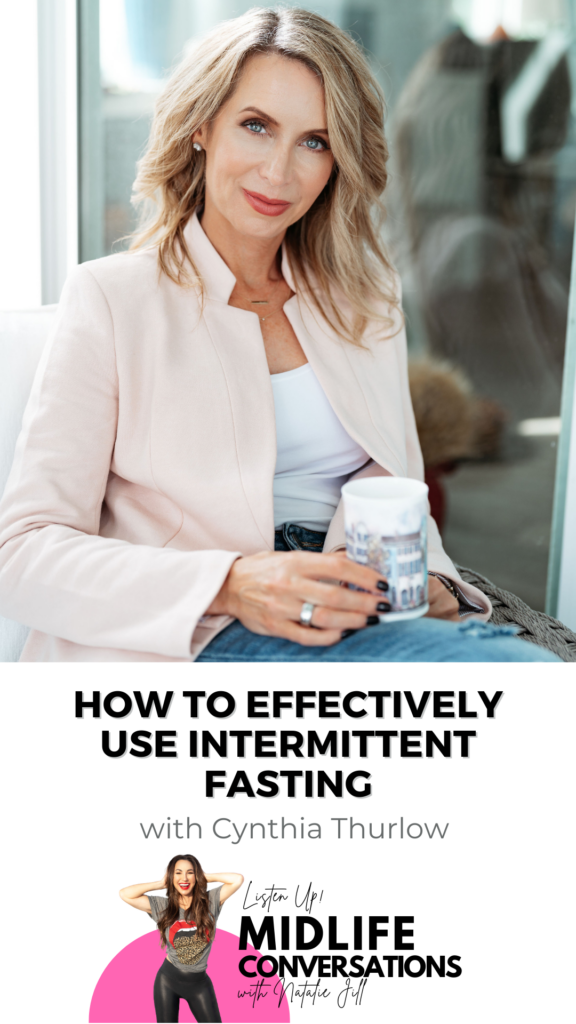How to Effectively Use Intermittent Fasting with Cynthia Thurlow
I’ve got Cynthia Thurlow on to talk all about Intermittent Fasting with us! She has changed not only her OWN life with intermittent fasting, but has changed the lives of sooo many. She is a 2X TEDx speaker and her second talk has over 13 MILLION views! This is SUCH an important topic for midlife women, and while it’s not a new concept, it’s necessary in our modern day lifestyle. For years we have been told to eat snacks, and have frequent mini meals, and to “stroke” our metabolism by not waiting too long in between meals – you name it. We have figured out that that is simply NOT the case.
Aging does NOT have to mean automatic weight gain! Midlife can be the best years if you try to remain open to the possibility that intermittent fasting could be what really help you feel so much better in your body.
How Did Cynthia Get Into Fasting?

Even with her medical background, nothing had prepared her for perimenopause. In her early 40s she was over exercising, eating too low carb, too much stress, and had become exhausted and weight loss resistant. A few people mentioned one week to try fasting. She was totally against it until she bought The Complete Guide for Fasting: Heal Your Body Through Intermittent, Alternate-Day, and Extended Fasting by Dr. Jason Fung. She decided to try it and felt better almost instantly. She felt better, had mental clarity, more energy, and ended up losing extra fluff that every middle aged woman seems to have a little bit of trouble losing.
What Is Intermittent Fasting and How Long Do We Have to Fast?
In simple terms, Intermittent Fasting just means eating less often. There are a number of different theories and ways to go about intermittent fasting, but it all comes down to just eat less often.
Cynthia is personally a fan of women having at least two meals in a feeding window so naturally she is a fan of a wider feeding window (to allow more time to eat enough). She recommends about a 6-8 hour eating window to make sure you are able to consume enough protein to preserve and protect lean muscle so you keep your body healthy and remain insulin sensitive.
These 8 hours are NOT 8 hours of grazing. It’s eating a balanced meal when you break and then eating another full balanced meal 5 hours later (for example). If you need up to 3 meals, that’s fine! Women should aim to get 100 grams of protein per day, so use your meals to increase your protein intake until you reach that goal. Women are grossly under consuming protein and is the reason they are rarely satiated, cannot build or maintain muscle, etc. Once you are eating the right macros, it’s easier to space your meals.
What Is Insulin Sensitive?
At least 93% of the United States population is no longer insulin sensitive. We have become insulin resistant as a byproduct of our modern day lifestyle. Our muscles are no longer in a position where our muscles are able to soak up extra carbs we have consumed. Insulin sensitivity is referring to do you have a healthy blood pressure? What is your waist circumference? How are your lipids? What is your fasting blood sugar?
Insulin sensitivity is the cornerstone of MOST chronic diseases and is the reason Intermittent Fasting is such an important tool to help us regulate our blood sugar and remain healthy. A lot of women do not understand that some of our sex hormones, like estrogen, help to protect us until we go into menopause. As we lose estrogen, it can exacerbate this process.
What Causes Blood Sugar Spikes?
When we eat food, depending on what we are eating (fat, protein, carb), our blood sugar will increase proportionately. For example, carbs will create a bigger spike; fat creates a lower spike. Insulin is another hormone that is secreted to help bring your blood sugar back down. What is important to know is that when we are giving ourselves a break from eating, and balancing our meals properly, then insulin is being secreted less often, as our blood sugar is spiking less often.
The Best Way to Check Your Fasting Insulin On Labs
A fasting insulin is the best way to check because it is usually the FIRST biomarker to flag attention that there might be an issue, way before A1C and fasting blood sugar issues. It’s inexpensive ($12-$20 usually) and is covered by insurance and every woman should be checking it!
Does Keto and Intermittent Fasting Do the Same Thing for Lowering Fasting Insulin?
The average American is consuming over 200 grams of carbohydrates each day.
To maximize results with either keto or Intermittent Fasting, you’re looking to have a net carb intake of less than 50 grams. If you have a CGM you can monitor your personal response to meals. This knowledge is king.
It’s important to know how YOU personally respond to even a “healthy” meal. Ideally you will see a 20-25 point jump after a meal. If you are over that, it’s time to recalibrate your macros for your meals. If your blood sugar is going over 140, you are creating microvascular damage to the inside of your blood vessels. It’s not benign to have your blood sugar elevated. Lower carb diets are therefore very beneficial for those who are insulin resistant.
What Is Good About Carb Cycling?
Even though low carb diets are beneficial, really restrictive diets (under 30 carbs) like keto, are often hard to maintain. This is why Cynthia recommends carb cycling. Carb cycling is allowing people to PLAY with carbohydrates so they don’t have a super restrictive diet. The idea of carb cycling is that on the days you are more active (like lifting heavy), you can eat more carbs, while on the days you are maybe more sedentary (days you dont workout), you eat lower carbs.
Carbs can be in a number of different forms. For Cynthia, her higher carb days are the days she eat fruit, and fruit vegetables. If you can tolerate grains, you might add a small serving of grains. Instead of having 70g carbs, maybe you’re having 100-150g. But it depends on the person and what works best for you.
Benefits of Intermittent Fasting and Getting Started
You will experience so many benefits:
- Mental clarity from lower blood sugar and lower insulin
- More energy
- Improvement in autophagy (clearing out dysfunctional dead cells that need to be released from our body)
- Improved blood sugar
- Improved blood pressure
- Improved lipids
- Lowered risk of neurocognitive issues (parkinsons, alzheimer’s, dementia)
- Reduced risk of cancers
- Improved gut health
- Better sleep
- Less stressed
- More life participation due to increased well-being
To get started, first thing first, stop snacking. Secondly, work on adjusting your macros. Third, go from not eating between dinner and breakfast (no nighttime drinking or snacking, etc.). This is a really easy time to fast because the majority of it is spent sleeping.
This and SOOO much more in this episode!
About Cynthia Thurlow
Cynthia Thurlow is a nurse practitioner, intermittent fasting and nutrition expert, and a two-time TEDx speaker. She is passionate about helping women find wellness through the healing power of nutrition and fasting. Cynthia believes it is possible to feel better tomorrow than you do today and want to equip you to experience that freedom!
In this episode, you will learn:
- The importance of intermittent fasting
- Why in Midlife you should be fasting
- The different types of intermittent fasting
- Which method of IF would work for you
- How to begin fasting
- How fasting helps with cognitive functions
